Current Status of Developing Primary School Teacher Training Programs Approaching Cdio
TS. Bùi Văn Hùng (Phó trưởng khoa Tâm lý-Giáo dục) và cộng sự
Abstract:Developing primary school teacher training programs approaching CDIO is a solution to enhance the quality of primary teacher education. Based on the requirements of the steps in constructing primary school teacher training programs approaching CDIO, the article surveys the current status of developing primary school teacher training programs in various aspects: analyzing the context of primary school teacher training, identifying the objectives of primary school teacher training, establishing the learning outcomes of the primary school teacher training programs approaching CDIO, designing the curriculum for primary school teacher training approaching CDIO, constructing detailed course outlines, and evaluating the training program according to CDIO standards. The survey results identify the strengths and weaknesses of the current situation, from which recommendations are made to improve the effectiveness of developing and advancing primary school teacher training programs that approach CDIO standards.Keywords:Program, teacher training program, CDIO approach, current status
1.Introduction
Primary education serves as the foundation of the national education system, aiming to “establish the initial basis for the development of morality, intelligence, physical well-being, aesthetics, and capacities of students; preparing students to proceed to lower secondary education” (National Assembly, 2019). Training primary school teachers is a pressing requirement to meet the demand for human resources in primary schools, especially as the sector is currently implementing the 2018 General Education Program. This program is designed to ensure “the development of learners' qualities and capacities through essential, practical, and modern educational content; harmonizing ethics, intellect, physical well-being, and aesthetics; emphasizing practice and the application of acquired knowledge and skills to solveproblems in learning and life; with high integration at lower levels and gradual differentiation at higher levels, utilizing educational methods and organizational forms that promote students' potential, with assessment methods aligned with educational objectives” (Ministry of Education and Training, 2018).The curriculum is a core element when studying any educational model, institution, or related content. A comprehensive and in-depth understanding of the curriculum helps educators establish clear directions for educational activities. For over a century, the curriculum has been a focal point of both theoretical and practical research. Different approaches to curriculum development have emerged, resulting in diverse curriculum designs. Traditional models often emphasize inputs, objectives, subjects, content knowledge, and lecturers. However, a growing focus has shifted towards outcomes and students' learning achievements. Modern approaches place more emphasis on learners' competencies and understanding rather than simply transmitting content knowledge (Egan, 2003; Wiles et al., 2011). Learners must adapt to various contexts to demonstrate their mastery of what they have learned. Notably, the performance-based competency approach has attracted increasing attention. This approach defines competency as the ability to confront complex situations by mobilizing specific knowledge and cognitive and non-cognitive resources. The increasing interest in the quality and relevance of education, along with the need to establish competency-based educational frameworks, has made this approach a vital component of educational theory and practice. Performance-based curricula tend to avoid a subject-based approach, emphasizing cross-disciplinary exploration or offering more realistic scenarios in specific fields (Henson, 2015; Oliva et al., 2019).
In recent years, many leading universities around the world have implemented CDIO-based training programs. CDIO stands for Conceive –Design –Implement –Operate, and is a philosophy aimed at developing the core competencies of engineers to meet product lifecycle requirements. This model has inspired several studies on curriculum development (Schedin et al., 2016; Edström, 2020).
In Vietnam, the CDIO approach was first introduced in 2010 in several engineering programs at the University of Technology and the University of Natural Sciences (Vietnam National University, Ho Chi Minh City). Since then, many Vietnamese universities haveapplied the CDIO approach to various disciplines, including Law and Economics. Some universities with education faculties have also begun developing CDIO-based teacher training programs. CDIO-based curriculum development, initially designed for engineering programs, requires comprehensive research on both theoretical and practical levels to be appropriately adapted to teacher training programs, including primary teacher education.
Developing CDIO-based primary teacher training programs is crucial for enhancing the quality of teacher education, bridging the gap between universities and primary schools, and fostering a team of creative, highly skilled teachers. The effective operationand development of these programs are essential. However, current university practices show that the most challenging aspect is the management of CDIO-based teacher training programs. Overcoming this challenge is key to improving the quality of primary teacher education in general and the effectiveness of CDIO-based primary teacher training programs in particular. Therefore, researching the current status of program development, and proposing scientifically-based, feasible recommendations for managing the development of CDIO-based primary teacher training programs, is an urgent issue from both theoretical and practical perspectives.
2.Theoretical Overview of the Main Concepts
* OVERVIEW OF DEVELOPING CDIO-BASED PRIMARY SCHOOL TEACHER TRAINING PROGRAMS
-Basic Concepts
Training ProgramAccording to Wentling (1993), a training program is a comprehensive design for a training activity. This overall design outlines the entire training content, specifying what can be expected from learners after completing a course. It describes the necessary procedures to implement the program content and indicates teaching methods and ways to evaluate learning outcomes, all within a structured timetable.
According to Frey, a training program is a systematic presentation of teaching and learning activities planned over a defined period, with the outcome being a defined system of various components aimed at preparing, implementing, and optimally evaluating teaching and learning activities.
Nguyen Duc Chinh(2015) defines a training program as a comprehensive and systematic plan for all educational activities within a school. It includes educational objectives, learning outcomes, educational content (with breadth and depth corresponding to the outcomes), educational methods and organizational forms (with suitable teaching methods, tools, and techniques), and methods for evaluating educational results (compared to the program's learning outcomes).
From these definitions, we understand that a training program is a system of educational activities designed and organized to achieve specific training objectives. The program includes objectives, the scope of knowledge, content structure, methods, and evaluation forms for each subject, discipline, or educational level.
CDIO-Based Training Program
A CDIO-based training program adheres to a strict process that begins with designing learning outcomes, building the program framework, implementing the framework in real-life training, and assessing both the learning outcomes of students and the entire program.
A CDIO-based program has several key characteristics: It is based on societal requirements for knowledge, skills, and attitudes; it integrates knowledge and skills, including broad and deep foundational knowledge with personal, communication, and system-building skills; it focuses on practical teaching, maximizing active, experiential, and integrated learning methods for students; and it is continuously improved to meet international quality standards, such as ABET in the U.S., NAAB in Canada, and CACB in Europe.
-Requirements for Developing CDIO-Based Primary School Teacher Training Programs
The requirements for developing CDIO-based primary school teacher training programs are reflected in each step of the program development process (Nguyen Ngoc Hien & Thai Van Thanh, 2022):
Analyzing the context of primary teacher training:This includes analyzing learners' needs (employment prospects after graduation, pre-and post-course knowledge and skills, and learning motivation), the characteristics of training institutions (mission, vision, core values, and faculty quality), and the demand for primary school teachers in the labor market.
Defining the objectives of primary teacher training:The objectives should clearly define the competencies and qualities necessary for teachers to excel not only in teaching but also in their role as independent researchers in primary education. The training objectives must emphasize adaptability to the evolving demands of education and society, driven by the Fourth Industrial Revolution. Therefore, the objectives should balance the core values of teaching with the “dynamic” development of new competencies.
Establishing the learning outcomes of the CDIO-based primary teacher training program:Learning outcomes must clearly encompass the knowledge and skills that students need to acquire after completing the program. These outcomes should reflect the needs of various stakeholders (students, parents, employers) and be periodically reviewed and adjusted.
Designing the curriculum for the CDIO-based primary teacher training program:When designing the curriculum, it is important to ensure that the program's objectives align with the learning outcomes and the requirements of primary school teacher training. The curriculum structure must include the knowledge and skills outlined by CDIOstandards and the universities offering the program. The curriculum description should be comprehensive and up-to-date, with an appropriate training schedule aligned with CDIO and primary teacher training characteristics.
Constructing detailed course outlines:The detailed course outlines must include all required information and contribute clearly to achieving the learning outcomes. Course content must be logically structured, updated, and integrated. Teaching methods should be based on integrated learning and active student participation, while assessmentmethods must be diverse and appropriate to measure students' achievement of the learning outcomes.
Evaluating the primary teacher training program according to CDIO standards:Evaluating the program requires using CDIO's 12 standards. Evaluations should be conducted at each stage of program development, not just at the final stage. During the evaluation, it is important to identify both the achieved and unachieved requirements, and propose necessary adjustments and improvements at each stage of the program development process.
3.Methodology
Conducting analysis -synthesis, systematization, generalization, modeling, and concretization of theoretical documents on developing primary teacher training programs aligned with the CDIO approach, aiming to build the theoretical and legal framework for the article, which serves as a basis for assessing the current situation and proposing solutions for the research topic.
Utilizing methods of analysis, comparison, synthesis, classification, and systematization of both domestic and international theoretical materials related to the development of primary teacher training programs following the CDIO approach to establish a theoretical foundation. This guides the design of tools for surveying the current status of the development of primary teacher training programs with the CDIO approach.
Expert method: Through conferences, scientific seminars, and consultations with experienced education experts and educational management personnel at various levels to survey the management of primary teacher training programs at training institutions. Expert opinions are collected through questionnaires and interviews regarding the survey questions, research findings, and proposed solutions.
The interview method is the fastest and simplest way to gather opinions from the interviewees. The greatest advantage of this method is that it enables the interviewer to discover new perspectives. This method aims to collect information on the core issuesof the article. The interviewees include university leaders (Chairpersons of University Councils, Presidents, Vice Presidents); Heads of Faculties and Heads of Departments in charge of primary teacher training; lecturers involved in primary teacher training, and students majoring in Primary Education from five universities: Vinh University, Thu Dau Mot University, Hanoi National University of Education, Saigon University, and Quy Nhon University. In-depth interviews assist the interviewer in identifying the viewpoints of the interviewees and offering an overall perspective on different stakeholders. These new perspectives will serve as a foundation for researchers to build theoretical frameworks and expand the research topic.
This method is particularly useful in qualitative research.This method also surveys the current status of developing primary teacher training programs aligned with the CDIO approach. The survey participants include university leaders (Chairpersons of University Councils, Presidents, Vice Presidents); Heads of Faculties and Heads of Departments in charge of primary teacher training; lecturers involved in primary teacher training, and students majoring in Primary Education from five universities: Vinh University, Thu Dau Mot University, Hanoi National University of Education, Saigon University, and Quy Nhon University. The quantitative survey sample comprises 585 participants, including 25 university leaders and Heads of Primary Education Departments (100%); 15 Department Heads (100%); 115 lecturers (100%) and 430 students (20%). The gender ratio is 81.8% female and 18.2% male. Most respondents (excluding students) have between 5-10 years of work experience (22.6%) or more than 10 years (77.4%). The results from the questionnaires were analyzed and compared to guide the research direction of the topic.Research Method for Product Activity: Based on self-assessment reports and external evaluation reports of the training programs (CTĐT) at elementary teacher training institutions to compare and cross-check with survey data, thereby drawing well-founded conclusions about the research issue.Experience Summarization Method: Stemming from the realities of educational management and the real-life experiences of managing elementary teacher training programs at the training institutions to gather feedback for managing these programs using the CDIO approach.
Data processing method. For quantitative data, the collected data will be processed using SPSS software. In the research project, the author calculates statistical measures, mean scores, and standard deviations to evaluate the current situation. For qualitative data, the content will be extracted according to each section of the research for analysis (interpretation, demonstration, etc.) of the research content.
4.Discussion
4.1. SURVEY ORGANIZATION
Survey subjects:
The survey involved the leadership of universities (Chairpersons of University Councils, Rectors, Vice Rectors), Heads of Faculties and Departments trainingprimary school teachers, lecturers involved in primary school teacher training, and students of the Primary Education program from five universities: Vinh University, Thu Dau Mot University, Hanoi National University of Education, Saigon University, and Quy Nhon University. The quantitative sample consisted of 585 people, including 25 university leadersand heads of the Primary Education Faculty (100%), 15 department heads (100%), 115 lecturers (100%), and 430 students (20%). The gender ratio was 81.8% female and 18.2% male. Most respondents (excluding students) had working experience ranging from 5-10 years (22.6%) to over 10 years (77.4%).
Survey content and tools:
The survey content focused on the current status of developing CDIO-based primary school teacher training programs. The survey tools included three questionnaires (for management staff, lecturers, and students). The quantitative questionnaire was developedbased on the requirements for building CDIO-based primary school teacher training programs. The survey aimed to assess the level of implementation and the results achieved in the development of CDIO-based primary school teacher training programs.The interview form for management staff and lecturers included questions directly related to the research topic.
Processing survey results:
Quantitative data were coded and processed using Excel and SPSS 21.0 software with descriptive statistical techniques. The scales included five levels from 1 to 5. The value range between levels was (5-1)/5 = 0.8 (from 1.00-1.80: Not implemented/No results; from 1.81-2.60: Rarely implemented/Weak; from 2.61-3.40: Moderately implemented/Average; from 3.41-4.20: Often implemented/Good; from 4.21-5.00: Frequently implemented/Excellent).Interviews were conducted with five management staff members coded from CBM1 to CBM5 and five lecturers coded from MD1 to MD5.
4.2. SURVEY RESULTS
Developing CDIO-based primary school teacher training programs was evaluated based on the following factors: analyzing the context of primary teacher training, defining the objectives of primary teacher training, establishing learning outcomes, designing the CDIO-based curriculum, constructing detailed course outlines, and evaluating the program according to CDIO standards.
Current status of analyzing the context of primary teacher training:
The current status of analyzing the context of primary teacher training was assessed based on the following criteria: analyzing learner needs, analyzing the characteristics of training institutions, analyzing the demand for primary school teachers in the labor market, analyzing trends in program quality accreditation, and analyzing the legal basis for building and developing training programs.
Table 1: Survey on the implementation level and results achieved in analyzing the context of primary teacher training
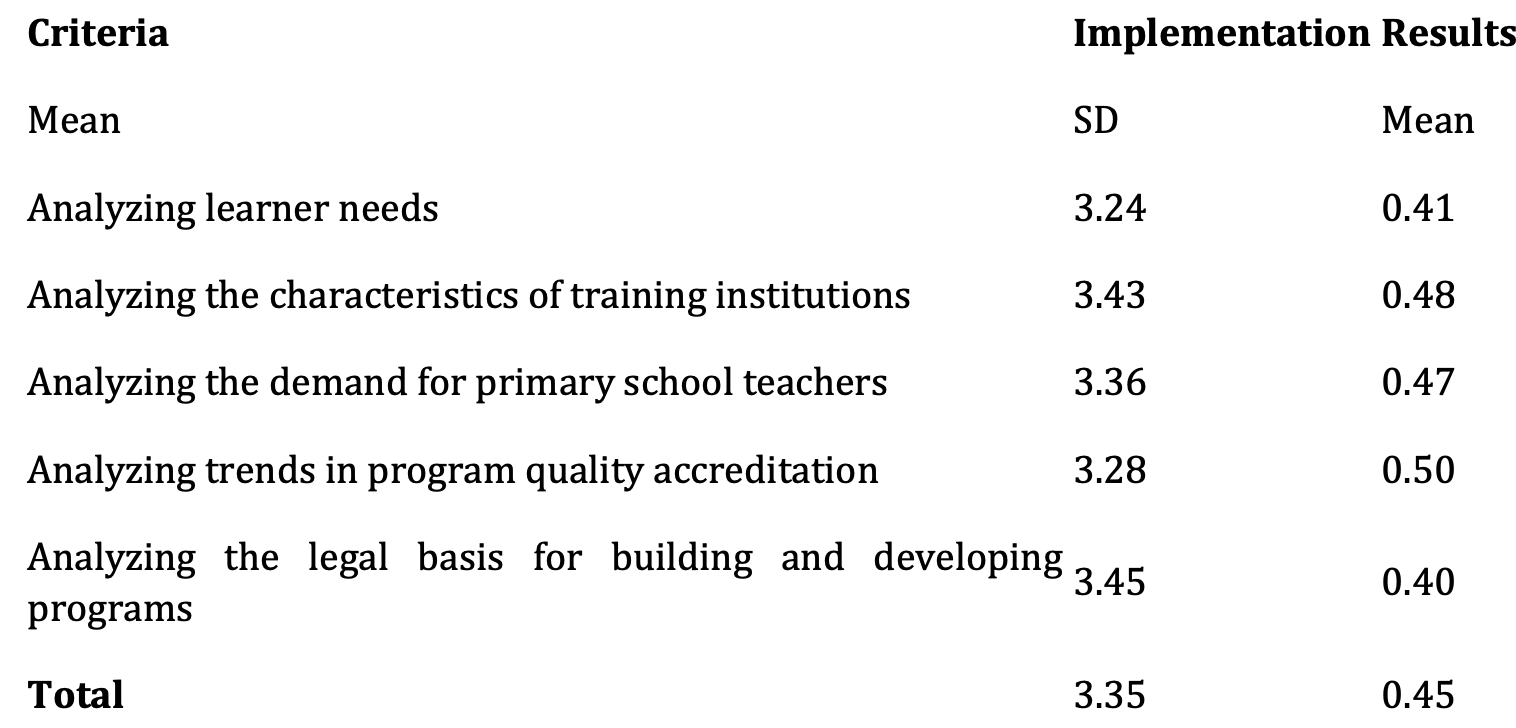
The results in Table 1 show that:
Overall, the implementation level (M=3.35, SD=0.45) and the results achieved (M=3.31, SD=0.43) in analyzing the context of primary teacher training in surveyed universities are at a moderate/average level.
Among the evaluation criteria for analyzing the context of primary teacher training, only two criteria: analyzing the legal basis for building and developing programs and analyzing the characteristics of training institutions, reached the level of “Often implemented/Good.” According to CBM1 and MD2, these two criteria are rated highly because building a training program requires clear identification of the legal basis and the specific conditions of the training institution.
The lowest-rated criterion was analyzing learner needs, with an implementation level (M=3.24, SD=0.41) and achieved results (M=3.13, SD=0.33). In discussions about this evaluation, CBM1 and MD2indicated that analyzing learner needs is the most limited aspect of the context analysis process. As a result, many issues related to learners, such as their employment prospects, their knowledge and skills before and after completing the program, and their motivation for learning, have not been fully clarified.
Current status of defining the objectives of primary teacher training:
The current status of defining the objectives of primary teacher training was evaluated based on the following criteria: the objectives are clearly defined, the objectives align with learning outcomes, the objectives emphasize high adaptability to the demands of primary education reform, the objectives reflect the changing role of primary school teachers in modern society, and the objectives show developmental potential.
Table 2: Survey on the implementation level and results achieved in defining the objectives of primary teacher training
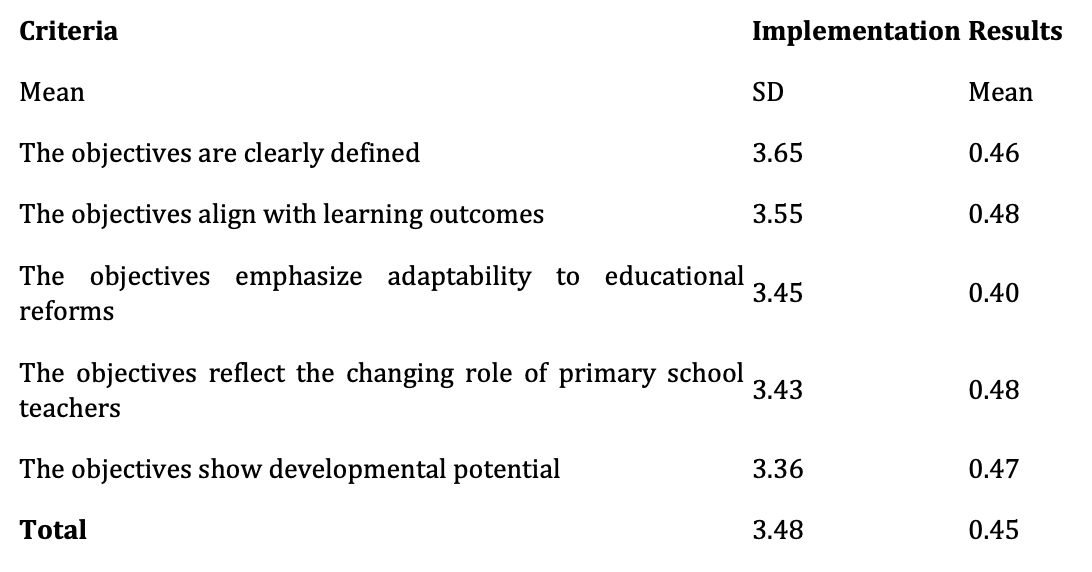
The results in Table 2 show that:In terms of implementation level, 4 out of 5 criteria for defining the objectives of primary teacher training were rated at the level of “Often implemented/Good.” Only one criterion, the objectives show developmental potential, was rated at the moderate level (M=3.36, SD=0.47).
In terms of results achieved, 4 out of 5 criteria were rated at the “Good” level, with the developmental potential of the objectives being rated at the “Moderate” level (M=3.34, SD=0.46). Overall, the activity of defining the objectives of primary teacher training was rated as “Good.”
According to MD1this evaluation reflects the objective reality of defining primary teacher training objectives in the development of training programs. The reason why this activity was rated highly is that during training workshops, management staff and lecturers were thoroughly briefed by experts on curriculum development. However, the weakness in defining primary teacher training objectives lies in the lack of developmental potential. The objectives should not only meet current requirements for the qualities and professional competencies of primary teachers but also anticipate future demands for those competencies.
Current status of establishing the learning outcomes of the CDIO-based primary teacher training program:
The current status of establishing the learning outcomes of the CDIO-based primary teacher training program was evaluated based on the following criteria: the learning outcomes are clearly defined, the learning outcomes encompass the necessary knowledge and skills, the learning outcomes reflect the requirements of stakeholders, the learning outcomes are publicly announced, and the learning outcomes are regularly reviewed and adjusted.
Current status of establishing the learning outcomes of the CDIO-based primary teacher training program:
The current status of establishing the learning outcomes of the CDIO-based primary teacher training program was evaluated based on the following criteria: the learning outcomes are clearly defined, they encompass the necessary knowledge and skills that learners need to acquire, they reflect the requirements of stakeholders, they are publicly announced, and they are regularly reviewed and adjusted.
Table 3: Survey on the implementation level and results achieved in establishing the learning outcomes of the CDIO-based primary teacher training program
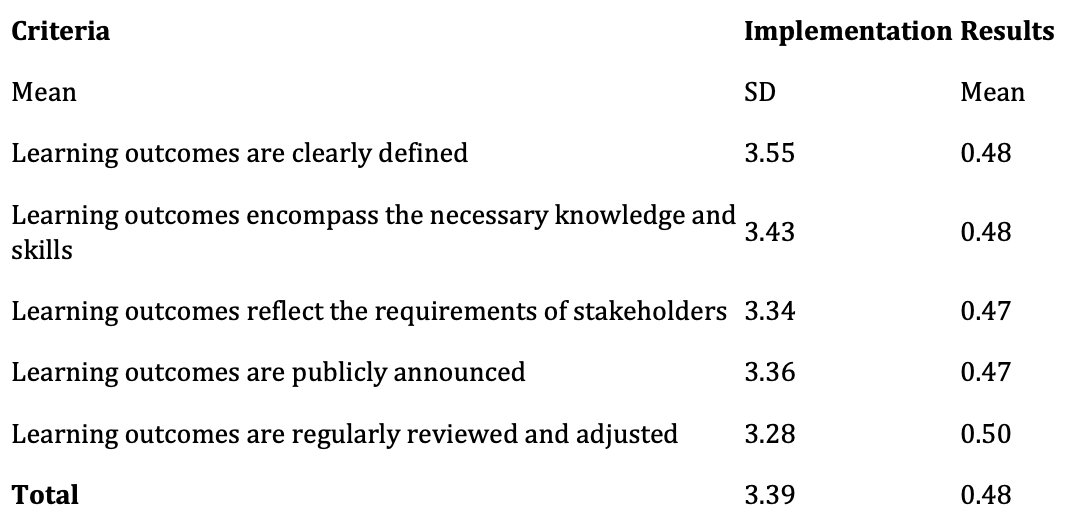
The results in Table 3 show that:
Among the evaluation criteria for establishing the learning outcomes of the CDIO-based primary teacher training program, the highest-rated criterion is “Learning outcomes are clearly defined” with an implementation level of (M=3.55, SD=0.48) and results achieved at (M=3.52, SD=0.49). The second highest-rated criterion is “Learning outcomes encompass the necessary knowledge and skills that learners need to acquire” with an implementation level of (M=3.43, SD=0.48) and results achieved at (M=3.41, SD=0.48).
The criteria that received the lowest evaluations were “Learning outcomes are regularly reviewed and adjusted” with an implementation level of (M=3.28, SD=0.50) and results achieved at (M=3.24, SD=0.41). Another lower-rated criterion was “Learning outcomesreflect the requirements of stakeholders” with an implementation level of (M=3.34, SD=0.47) and results achieved at (M=3.32, SD=0.46). According to CBQL2 and GV1, the reason these two criteria received lower ratings is that universities implementing CDIO-based primary teacher training programs are primarily in the experimental phase, so there hasn’t been much opportunity to regularly review and adjust the learning outcomes, nor to gather feedback from stakeholders regarding the program and its outcomes.
Current status of designing the CDIO-based primary teacher training program:
The current status of designing the CDIO-based primary teacher training program was evaluated based on the following criteria: ensuring that the program’s objectives are met, aligning with the learning outcomes and the requirements of primary teacher training, structuring the curriculum to include the necessary knowledge and skills, providing a comprehensive and updated description of the program, and developing a training plan and schedule appropriate to the CDIO approach and primary teacher training.
Table 4: Survey on the implementation level and results achieved in designing the CDIO-based primary teacher training program
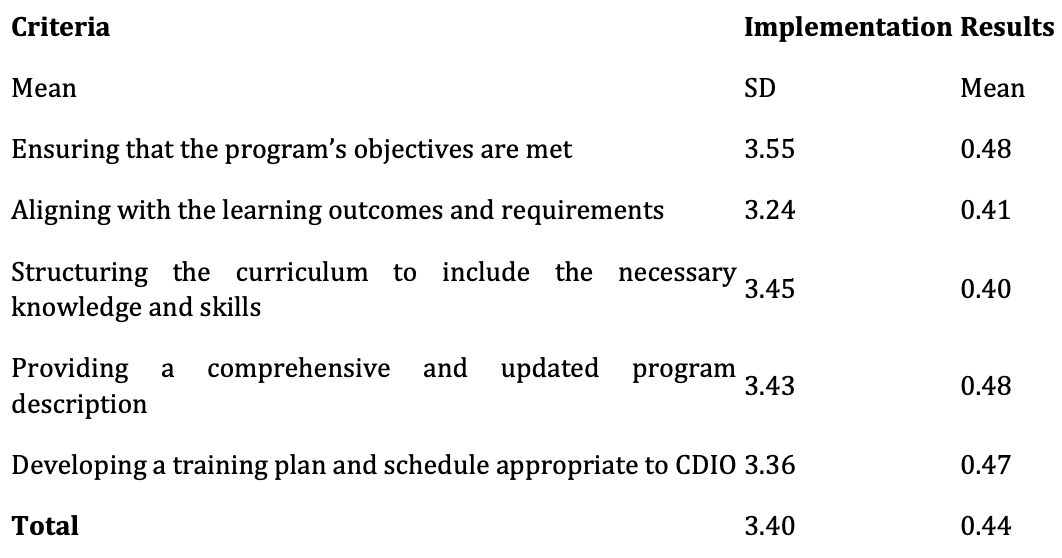
The results in Table 4 show that:
Surveyed subjects did not highly evaluate the activity of designing the CDIO-based primary teacher training program. Overall, the implementation level was rated as moderate (M=3.40, SD=0.44), and the results achieved were rated as average (M=3.36, SD=0.44).
According to CBQL3, designing a CDIO-based primary teacher training program is still a new task for many lecturers. They need both knowledge of CDIO and skills in curriculum design. However, not all lecturers have the necessary knowledge and skills to design a CDIO-based primary teacher training program.
Among the evaluation criteria for designing the CDIO-based primary teacher training program, the criterion “Ensuring that the program’s objectives are met” received the highest rating, while the criterion “Aligning with the learning outcomes and requirements of primary teacher training” was rated the lowest. According to CBM4, this reflects the strengths and limitations in the activity of designing the CDIO-based primary teacher training program in universities.
Current status of constructing detailed course outlines:
The current status of constructing detailed course outlines was evaluated based on the following criteria: the course outlines include all required information, the courses clearly contribute to achieving the program’s learning outcomes, the course contentis logically structured, updated, and integrated, the teaching methods are based on ntegrated learning and active student participation, and the assessment methods are diverse and appropriate for determining the achievement of learning outcomes.
Table 5: Survey on the implementation level and results achieved in constructing detailed course outlines
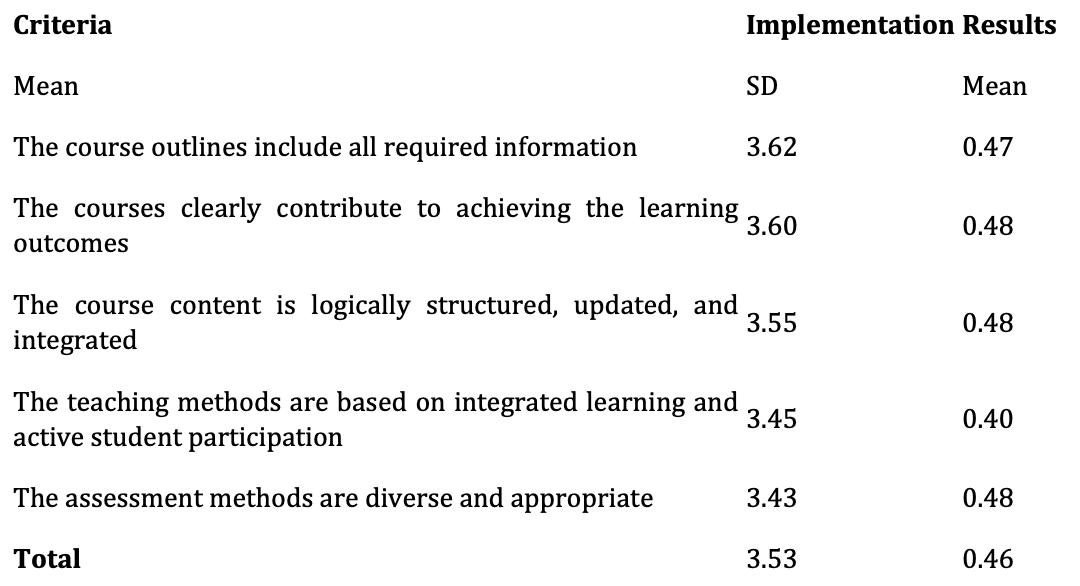
The results in Table 5 show that:
Constructing detailed course outlines is one of two activities (along with defining the objectives of primary teacher training) that received high ratings from the survey participants. The overall implementation level was rated as “Good” (M=3.53, SD=0.46),and the results achieved were also rated as “Good” (M=3.50, SD=0.48).
GV3 explained that during the development of CDIO-based primary teacher training programs, the construction of detailed course outlines was the most thoroughly trained activity. Lecturers were guided to construct CDIO-based course outlines for the specificcourses they were responsible for. As a result, this activity was rated highly, which is reasonable.
Among the evaluation criteria for constructing detailed course outlines, the lowest ratings were given to the criteria related to teaching methods and assessment methods. According to CBM4, the CDIO approach requires teaching methods to be based on integrated learning and active student participation, and the assessment methods must be diverse and appropriate. However, not all lecturers are ready to innovate their teaching methods and assessment methods. CBM4emphasized that this will be a significant challenge for universities implementing CDIO-based primary teacher training programs.
Current status of evaluating CDIO-based primary teacher training programs:The evaluation of CDIO-based primary teacher training programs was assessed based on the following criteria: evaluation is based on 12 CDIO standards, evaluation is conducted at all stages of the program development process, the evaluation identifies the requirements that have been met, it highlights unmet requirements in each stage of the CDIO-based program development process, and proposes adjustments and improvements at each stage.
Table 6: Survey on the implementation level and results achieved in evaluating CDIO-based primary teacher training programs
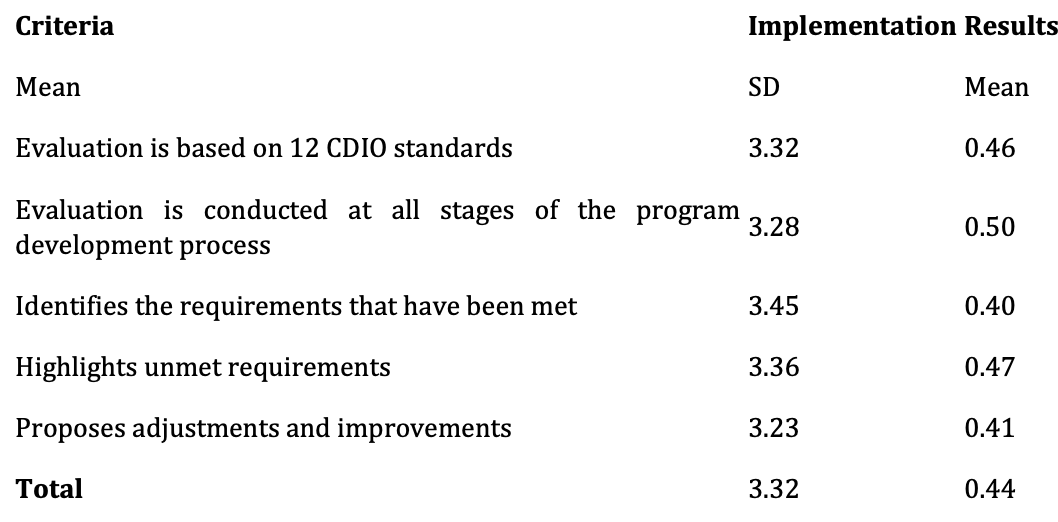
The results in Table 6 show that:
In developing CDIO-based primary teacher training programs, the evaluation process received the lowest ratings from the survey participants (M=3.32, SD=0.44 for the implementation level; M=3.28, SD=0.42 for the results achieved).
The criterion “Proposes adjustments and improvements” was rated the lowest, followed by “Evaluation is conducted at all stages of the program development process” and “Evaluation is based on 12 CDIO standards.” According to CBM5this result reflects the limitations of the evaluation process in CDIO-based primary teacher training programs. These limitations need to be addressed to improve the program development process.
Summary of the implementation level and results achieved in developing CDIO-based primary teacher training programs:
The implementation level and results achieved in developing CDIO-based primary teacher training programs are summarized in Chart 1:
Chart 1: Summary of the implementation level and results achieved in developing CDIO-based primary teacher training programs
In the chart, 1: Analyzing the context of primary teacher training; 2: Defining the objectives of primary teacher training; 3: Establishing learning outcomes for CDIO-based primary teacher training programs; 4: Designing the CDIO-based curriculum; 5: Constructing detailed course outlines; 6: Evaluating CDIO-based primary teacher training programs.
The results in Chart 1 show that among the activities in developing CDIO-based primary teacher training programs, constructing detailed course outlines was rated the highest, followed by defining the objectives of primary teacher training. The lowest-rated activities were evaluating CDIO-based primary teacher training programs and analyzing the context of primary teacher training. This evaluation objectively reflects the current status of developing CDIO-based primary teacher training programs in the surveyed universities.
To assess the correlation between the implementation level and the results achieved in developing CDIO-based primary teacher training programs, we used the Spearman rank correlation coefficient (rs).
Where D is the difference between the two quantities being compared, and n is the number of activities surveyed. The calculated result is rs = 0.942. This correlation value shows that there is a positive correlation between the implementation level and theresults achieved in the development of CDIO-based primary teacher training programs. This allows us to confirm the reliability of the survey results, providing a solid basis for organizing and directing the implementation of the requirements for developing CDIO-based primary teacher training programs in universities.
4.3. RECOMMENDATIONS FOR DEVELOPING CDIO-BASED PRIMARY TEACHER TRAINING PROGRAMS
In developing CDIO-based primary teacher training programs in universities, despite the achievements, there are still challenges related to analyzing learner needs, ensuring the developmental potential of training objectives, reflecting stakeholder requirements in learning outcomes, aligning the curriculum with learning outcomes and the requirements for primary teacher training, and innovating teaching methods and assessment methods according to CDIO standards. The primary cause of these challenges lies in the management of developing CDIO-based primary teacher training programs. Therefore, we propose the following recommendations:
•Organize training sessions for management staff and lecturers on the necessity of managing CDIO-based primary teacher training programs, emphasizing that managing such programs is one of the key tasks in managing training activities at universities in the current context.
•Organize the development of learning outcomes for CDIO-based primary teacher training programs, ensuring they comply with regulations and follow a defined process; develop criteria to evaluate the effectiveness of managing the development of learning outcomes for CDIO-based primary teacher training programs.
•Review and redesign the current primary teacher training curriculum; organize the development of CDIO-based primary teacher training curriculum frameworks.
•Standardize and publish sample course programs for CDIO-based primary teacher training programs; organize the development of course programs for CDIO-based primary teacher training according to a defined process.
•Develop policies to promote innovation in the implementation and development of CDIO-based primary teacher training programs (Nguyen Ngoc Hien, 2022).
5.Synopsis of the Main Research Outcomes
The article examines the current state of developing primary school teacher trainin programs based on the CDIO approach (Conceive –Design –Implement –Operate). Below is a summary of the key research findings:
Analyzing the context of primary teacher training: The analysis of learner needs, institutional characteristics, and labor market demand shows a moderate level of implementation and results. However, the highest-rated criteria were analyzing the legal basis for program development and the characteristicsof the training institutions.
Defining training objectives: The objectives of primary teacher training programs were rated fairly well, with an emphasis on adaptability to educational reforms and the changing role of teachers in modern society.
Establishing learning outcomes: The establishment of learning outcomes for the CDIO-based primary teacher training programs also received a good evaluation. However, there were limitations in regularly reviewing and adjusting outcomes, as well as in reflecting stakeholder requirements.
Designing the training program: The design of CDIO-based primary teacher training programs is still a new task for many lecturers, and the results achieved are only moderate. This indicates the need for further development of CDIO knowledge and curriculum design skills.
Constructing detailed course outlines: This was the highest-rated activity, with well-structured course outlines that contribute effectively to achieving the learning outcomes. However, teaching methods and assessment techniques still require improvement to meet CDIO standards.
Evaluating the training program: The evaluation of CDIO-based primary teacher training programs was the lowest-rated activity, particularly in proposing improvements and conducting evaluations at every stage of program development.
The article provides specific recommendations to improve the management and development of CDIO-based primary teacher training programs. It emphasizes the importance of training management staff and lecturers, improving teaching and assessment methods, andreviewing learning outcomes to better align with stakeholder needs.
6.Conclusions
Developing CDIO-based primary teacher training programs is a key solution to improving the quality of primary teacher education. The process of developing CDIO-based primary teacher training programs consists of six steps, each with specific requirements. The survey on the current status of developing CDIO-based primary teacher training programs has objectively assessed the implementation level and the results achieved in each step, as well as in the overall process. Along with the successes, there are still challenges in developing CDIO-based primary teacher training programs, with the primary cause being the lack of effective management of program development. Therefore, it is necessary to implement the recommendations proposed in this article.
7.Limitations, Implications, and Further Directions of Research
Limitations:Lack of continuous adjustment and stakeholder feedback: The regular adjustment of learning outcomes and the collection of feedback from stakeholders are limited. This affects the program’s ability to be updated according to real-world demands and changes in education.
Teaching and assessment methods:
Although detailed course outlines have been developed, the teaching and assessment methods do not fully meet CDIO standards. There is a lack of innovation to encourage active student participation.
Limited experience in CDIO program development:
Lecturers and management staff still lack the knowledge and skills needed to design and manage training programs based on the CDIO approach. Program design is still in the pilot phase.
Significance:
Improving the quality of primary teacher education: The article emphasizes the need to apply the CDIO model to develop primary teacher training programs to enhance education quality and train teachers with the necessary skills to meet modern educational demands.
Strengthening management and teaching capacity: The research provides insights into the importance of effectively managing CDIO-based training programs. It also helps universities improve teaching methods and program management skills.
Meeting labor market demands: Developing CDIO-based programs helps bridge the gap between universities and labor market needs, training primary school teachers with the required skills to be adaptable and creative in their work.
Future research directions:
Further research on teaching and assessment methods in CDIO: Experimental studies are needed to improve teaching and assessment methods, ensuring they align with CDIO standards and encourage active student participation.
Expanding the application of CDIO: Future research should explore applying the CDIO model not only in primary teacher training but also in other education levels and fields, to evaluate the model's effectiveness and broader applicability.
Enhancing program evaluation: Future research should focus on evaluating the development stages of CDIO-based training programs and gathering feedback from various sources to timely adjust and improve the programs.
The article recommends that managing CDIO-based primary teacher training programs be strengthened, including the training of management staff and lecturers, as well as improving teaching and assessment methods to meet international standards.
References
1.National Assembly of the Socialist Republic of Vietnam (2019) Law on Education.
2.Ministry of Education and Training (2018) Circular No. 32/2018/TT-BGDĐT on Issuing the General Education Program.
3.K. Egan (2003) What Is Curriculum? Journal of the Canadian Association for Curriculum Studies. Volume 1 (Number 1 Spring 2003).
4.Jon W. Wiles and Joseph C. Bondi (2011) Curriculum Development: A Guide to Practice 8th Edition Pearson Education Boston.
5.Kenneth T. Henson (2015) Curriculum Planning: Integrating Multiculturalism, Constructivism, and Education Reform, Fifth Edition Waveland Press Inc United States.
6.Peter F. Oliva II, William R. Gordon, and Rosemarye T. Taylor (2019) Developing the Curriculum, 9th Edition Pearson Education London.
7.Staffan Schedin and Osama A.B. Hassan (2016) Work integrated learning model in relation to CDIO standards Journal of Applied Research in Higher Education. Vol. 8 (No. 3).
8.Kristina Edström (2020) The role of CDIO in engineering education research: Combining usefulness and scholarliness. European Journal of Engineering.
9.Wentling, Tim L. (1993) Planning for Effective Training: Guide to Curriculum Development Food and Agricultural Organization of the United Nations, Rome.
10.Karl Frey (1972) Theories of the curriculum Weinheim and Basel Beltz.
11.Nguyen Duc Chinh (2015), Educational Program Development. Vietnam Education Publishing House, Hanoi.
12.Vo Van Thanh (2011), CDIO Approach to Improving the Quality of Higher Education. Journal of Education, Issue 268 (second issue of August 2011).)
13.Pham Huu Loc Phạm Hữu (2015), CDIO Approach in Developing Articulated Training Programs to Improve Training Quality and Meet Social Needs. Journal of Education, Issue 367 (October 2015).
14.Nguyen Ngoc Hien, Thai Van Thanh (2022), Requirements for Developing CDIO-Based Teacher Training Programs. Journal of Science, Vinh University, Volume 50, Issue 4B/2021, pp. 31-37.
15.Nguyen Ngoc Hien (2022), Some Management Solutions for CDIO-Based Primary Teacher Training Programs. Journal of Science and Education of Vietnam, Issue 07, Volume 18/2022, pp. 1-7.
- Professional skills development for University lecturers: A case study in the Mekong Delta region of VietnamNghiên cứu10/06/2025
- Management of primary teacher training programs using the CDIO approach: Theoretical frameworks and practical implementationsNghiên cứu03/06/2025
- Nghiên cứu mối liên quan giữa tật cận thị và một số yếu tố khác với tình trạng lo âu của sinh viên 2 năm đầu đại họcNghiên cứu22/05/2025
- Mối liên quan giữa tình trạng lo âu với tật cận thị và một số yếu tố khác của sinh viên năm cuối đại họcNghiên cứu13/05/2025
- Đổi mới quản lý cơ sở giáo dục đại học trong bối cảnh tự chủ đại họcNghiên cứu01/05/2025
- Xây dựng và sử dụng khung năng lực trong phát triển đội ngũ giáo viên làm công tác tư vấn học đường ở trường tiểu họcNghiên cứu07/04/2025
- Tổng quan các nghiên cứu phát triển năng lực số cho sinh viên đại học ngành giáo dục tiểu họcNghiên cứu04/04/2025
- Bản đồ cơ thể đầu tiên về ảo giácNghiên cứu01/04/2025
- Điểm chuẩn ngành Sư phạm Tin họcKhoa Tin học23/08/2025
- Khoa Ngữ văn công bố mục tiêu và chuẩn đầu ra chương trình đào tạo trình độ thạc sĩ Ngôn ngữ Việt NamĐào tạo21/08/2025
- Học viên cao học K30 bảo vệ luận văn/đồ án Thạc sĩ ngành Quản lý giáo dục với loạt đề tài sát thực tiễnĐào tạo17/08/2025
- Thuốc điều trị ADHD giúp giảm nguy cơ tự tử, lạm dụng chất gây nghiện và hành vi phạm tộiTin tức15/08/2025
- Thông báo KQ xét cộng điểm thưởng cho thí sinh có thành tích vượt trội xét tuyển vào đại học chính quy trường Đại học Vinh năm 2025Tin tức15/08/2025
- Các chatbot trí tuệ nhân tạo (AI) có thể bị khai thác để trích xuất thêm nhiều thông tin cá nhân.Tin tức14/08/2025
- Mèo mắc chứng sa sút trí tuệ có những đặc điểm điển hình tương đồng với bệnh AlzheimerTin tức13/08/2025
- Cơ cấu tổ chức - Khoa Toán - Trường Sư phạm - Trường Đại học VinhCơ cấu tổ chức13/08/2025


